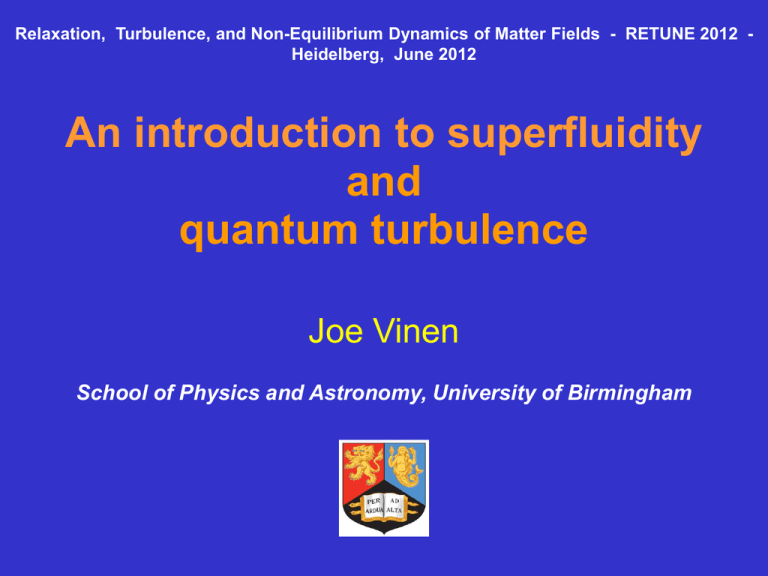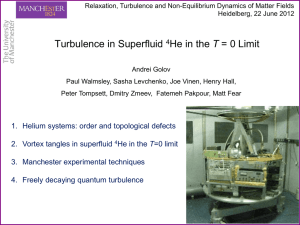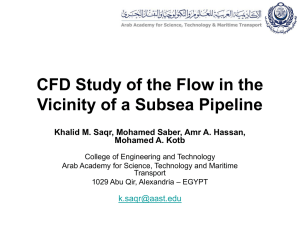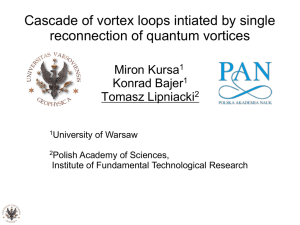Slides
advertisement

Relaxation, Turbulence, and Non-Equilibrium Dynamics of Matter Fields - RETUNE 2012 Heidelberg, June 2012 An introduction to superfluidity and quantum turbulence Joe Vinen School of Physics and Astronomy, University of Birmingham Superfluids Fluids that can exhibit frictionless flow: best known cases • liquid 4He below about 2.2 K • liquid 3He below about 2 mK • Ultra-cold atomic Bose gases. Other superfluid systems will be discussed later in workshop Superfluidity and Bose condensation Superfluidity is associated with Bose condensation (or in a Fermi system with something similar to Bose condensation involving pairs of particles). Bose condensation in an ideal gas is easy. With interacting particles, it is best understood in the form of the one-particle density matrix (Onsager & Penrose) r1 r2 * r1 r2 as r2 r2 Even with severe depletion of condensate by interactions where *(r) = +(r) is a “classical” phase coherent matter field - the condensate wave function. (r) is also the complex order parameter associated with the phase transition to the superfluid state. Loss of global gauge symmetry at Tc. If we write r r expiSr then associated with the Bose-condensate. v s r S r is the local velocity m (m is the mass of the particle undergoing condensation) The velocity vs(r) must be irrotational, and any circulation in a multiplyconnected volume must be quantized v s dr n where 2 m is the quantum of circulation. The superfluid velocity and its stability vs(r) is called the superfluid velocity. We might associate it with a mass current Js r s vs r (an observable quantity) Two questions: • Can such a mass current be (meta)stable, implying superfluidity ? • What is the value of s ? For the ideal Bose gas the current is not stable: single particle excitations destroy the moving condensate, even at T = 0: s = 0 However, with suitable particle interactions the spectrum of single-particle excitations is modified (free particles phonons (Goldstone modes)), and the supercurrent becomes stable against the production of these excitations (up to the Landau critical velocity). Then at T = 0, s . (although condensate fraction < 1.) At T > 0, excitations are generated thermally 0 s if T Tc ; s 0 if T Tc Hence two-fluid behaviour (normal fluid = excitations) Quantized vortices We have considered non-zero circulations in a multiply-connected volume. 2 m But we can also have a topological defect: a free vortex line (Onsager, Feynman), with || = 0 along a line in the fluid, a phase change of 2 round the line, and hence a circulation of . Can superflow be stable against the production of such a defect? Yes, if we take account of the interaction of the vortex with its image in a boundary. (Stability against the production of free vortex rings is similar.) Stability depends on quantization of circulation. Vortex nucleation: role in practice of remanent vortices (especially in 4He). Role of vortex lines in allowing steady rotation. Quantum turbulence The flow of a classical fluid is often turbulent. Turbulence necessarily involves rotational motion. So turbulence in a superfluid must involve quantized vortex lines, in the form of an irregular tangle. Hence quantum turbulence. Turbulent flow of a superfluid is in practice also very common. It provides us with a quantum system far from equilibrium, and we wish to understand how it can be generated, how it evolves, and how it can decay. Tsubota et al The different superfluids behave in different ways, and comparisons provide valuable insight. Comparison with classical turbulence provides further insight. Understanding quantum turbulence: the GP equation An understanding of classical turbulence must be based ultimately on the Navier-Stokes equation + the continuity equation. v 1 div v 0 (v )v p 2v t t Ideally we want a corresponding equation(s) that describes how the CWF evolves in time. For a weakly interacting Bose-condensed gas at T = 0 this equation is the non-linear Schrodinger equation (Gross-Pitaevskii equation) 2 2 2 i m V0 t 2m Write r r expiSr , vr mSr and 2 (small depletion of the condensate); then v i 1 1 p ij v j v j t 2 x i x i x j div v 0 t Note no viscous dissipation, and presence of quantum pressure term. The G-P equation: the coherence length, the vortex core, and vortex reconnections The G-P equation coherence length 2 2m 2 The coherence length determines the size of the vortex core. (Vortex core has a well-defined structure.) If two vortices come within a coherence length they can reconnect (contrast behaviour of Euler fluid). Very important! [Barenghi] An example of a solution of the G-P equation (Abid et al 2003) [Tsubota] Applicability of G-P equation; vortex filament model for 4He Good for Bose-condensed gases. is relatively very large. Quantitatively poor for real helium, in which interactions are too strong. ~ interatomic spacing. • In 4He: Condensate fraction ~ 0.1. • Reconnections known to occur in 4He (from experiment), but no theory or detailed model. • 3He (BCS condensate) is in between: ~ 80 nm. The vortex filament model for helium: • Vortices are regarded as thin vortex filaments behaving classically on scales >> . • They move with the local fluid velocity: the velocity due to other vortices being given by the Biot-Savart law v s r0 r r0 dr 3 4 r r0 • Reconnections (occurring on scale ~ ) are introduced artificially. The normal fluid and mutual friction So far we have ignored any normal fluid - present at a finite temperature. The normal fluid may or may not be turbulent. Any motion of the normal fluid relative to the vortex lines frictional force between the two fluids, known as mutual friction. Mutual friction acts on the core of a vortex and modifies the motion of the vortex in accord with the Magnus effect. It provides a major source of dissipation in quantum turbulence at a finite temperature, but can also lead to the generation of turbulence. The mutual friction decreases rapidly with temperature and is effectively absent for T / TC < ~ 0.2. Forms of quantum turbulence As with classical turbulence, quantum turbulence can take many forms; many are very complicated. Here we consider two typical and illustrative cases: • Homogeneous, isotropic turbulence (HIT) at T ~ 0 (no normal fluid) – some similarity to its classical analogue, but with important differences. Concerned mainly with the way it decays. Relevant experiments in 4He and 3He-B. • Turbulence produced by forced relative motion of the two fluids – no classical analogue. Concerned mainly with the way it is generated. Relevant experiments in 4He. HIT in a classical fluid: the Richardson cascade Classical grid turbulence in a wind tunnel v 1 (v )v p 2v t Richardson cascade Energy is injected into large turbulent eddies at large Reynolds number. It then decays through nonlinear interactions* (local in k-space) in a cascade of smaller and smaller eddies, until the eddies are so small that they have a Reynolds number ~ 1 and there is viscous dissipation. * Exactly how? Kolmogorov: In the inertial sub-range, no dissipation and local interactions E k ~ 2 3k 5 3 Quantum HIT at T = 0 Compared with classical case: • • No viscous dissipation A new “quantum” length scale : the vortex spacing Significance of the quantum length scale . • • Processes occurring on scales >> involve many quanta. Therefore essentially classical behaviour, described by Euler equation. Motion of scales < is a dominated by quantum effects (quantized vorticity; discrete vortex lines; vortex reconnections) Production of quantum HIT? By flow through a grid or by spin-down [Golov]. How does quantum HIT evolve and decay? To what extent is it similar to classical HIT? HIT at T = 0: theoretical expectations – two cascades? Injection of energy on large scale (>>); On a scale >>, we have a classical inertial range cascade with Kolmogorov spectrum (no dissipation) Large scale motion achieved by partial polarization of vortex tangle. Classical behaviour because local interactions ensure that system does not feel the quantum effects that dominate at scales <~. Energy flux k An inertial-range cascade requires dissipation k at a high wavenumber • Dissipation in an inviscid fluid? • Sound (phonon) emission (Bose superfluids)? On scales ~ , frequencies are too small. Transition region k~-1 • Motion on scales < ? Phonon emission during reconnections? Yes, in cold gases, but small in 4He. • But reconnections waves on vortices (Kelvin) • Kelvin-wave turbulence Kelvin-wave cascade phonon emission at scale of nm. [Golov] On scales ~, transition region (Structure controversial - bottleneck?) Nazarenko & Rudenko; Kozik & Svistonov; Sonin) (L’vov, HIT in 4He at T = 0: experimental evidence? Evidence for the Kolmogorov spectrum from observations of pressure fluctuations in 4He, and for “classical” deviations from Kolmogorov. Some indirect evidence for the rest. But the need for more direct evidence major experimental challenge. Turbulence in 3He and Bose-condensed atomic gases Superfluid 3He is more complicated than superfluid 4He: spin and orbital motion of the Cooper pairs makes the order parameter more complicated. But turbulence in 3He-B (but not in 3He-A) turns out to be quite similar to that in 4He, although • The coherence length is larger and the vortex core has a more complicated structure, providing another path to dissipation. • The normal fluid is very viscous and cannot itself be turbulent. • Superfluid 3He may be more closely analogous than superfluid 4He to situations in cosmology and particle physics. Turbulence can also be generated in Bose-condensed atomic gases. Again there can be more complicated order parameters. Phonon generation during reconnections is probably the dominant dissipative process. [Tsubota] Generation of quantum turbulence by forced counterflow I For example, thermal counterflow in 4He generates a self-sustaining homogeneous turbulence in the superfluid component. Computer simulations (vortex filament model + reconnections), pioneered by Schwarz. Adachi, Fujiyama, Tsubota PR B 81, 104511 (2010) • Turbulence is generated by the mutual friction • Reconnections play a crucial role • No classical analogue • Prediction by Melotte & Barenghi that flow of normal fluid is unstable, and confirmation in recent experiments. Yet another new type of turbulence. Generation of quantum turbulence by forced counterflow II Quantum turbulence can also be generated by the forced counterflow of two co-existing superfluids. [Tsubota] Summary and conclusions Bose condensation in a fluid of interacting particles involves the formation of a coherent matter field and leads to superfluidity. Phase coherence of the matter field leads to the quantization of circulation and to the existence of topological defects in the form of quantized vortices. These vortices allow a forms of turbulent motion in the superfluid. In some regimes this turbulent motion is similar to that in a classical fluid; in others it is quite different. Quantum turbulence can involve new turbulent phenomena: • New forms of turbulence. • New ways of generating turbulence. • New routes to the decay of turbulence, via characteristically quantum structures The two isotopes of helium and ultra-cold Bose gases behave in somewhat different ways, which can be instructive. Thank you








